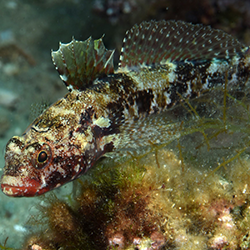New source of information on evolution of European gobies
A team led by LMU paleontologist Bettina Reichenbacher has demonstrated for the first time that ‘earstones’ and skeletal traits permit to recognize familial relationships of the fish.
25.07.2023
 Unravelling the evolution of European gobies. This pictures shows a specimen of Gobius cruentatus | © Uli Schliewen / SNSB-ZSM
Unravelling the evolution of European gobies. This pictures shows a specimen of Gobius cruentatus | © Uli Schliewen / SNSB-ZSM
Gobiidae (gobies) is one of the most species-rich families of marine and freshwater fish in Europe. They are generally quite small (maximum 10 cm), spend the vast majority of their lives on the floors of waterbodies, and make substantial contributions to the functioning of various ecosystems by virtue of their abundance and variety. An important strand of research into today’s gobies seeks to understand their evolutionary history through molecular analyses and with the help of fossils. Fossils are vitally important because they are the only direct evidence we have to know which gobies existed many millions of years ago.
It is a scientific challenge, however, to precisely classify fossil gobies – that is to say, determining to which present-day gobies they are most closely related. Molecular methods are of course not available for fossils, but we do have their hard parts, namely the bones of their skeletons, their teeth, scales, and ‘earstones’ – or otoliths to give them their scientific name. Otoliths are biomineralizations in the inner ear of gobies (and indeed all bony fish). Primarily, they help the fish with balance, orientation, and acoustic communication. But whether hard parts such as skeletal traits or otoliths permit precise classification of a goby fossil could not be established with certainty before now.
An international team of scientists led by Professor Bettina Reichenbacher from the Department of Earth and Environmental Sciences at LMU and the GeoBioCenter at LMU has now presented a comprehensive dataset on the skeletal traits and otoliths of present-day European gobies in the Zoological Journal of the Linnean Society. The researchers document that the morphology of otoliths allows classification at the levels of genus and species and even between closely related dwarf gobies, and that skeletal traits and morphometric otolith variables can be diagnostic for a goby lineage. They conclude that the new data are a valuable reference tool for evaluating the phylogenetic relationships of fossil gobies. “Our results pave the way for future research into goby fossils in the context of their familial relationships with the gobies of today, thus making a significant contribution to our knowledge of the evolutionary history of this highly interesting family,” says Reichenbacher.
Original publication
Reichenbacher, B., Vukić, J., Šanda, R., Schliewen, U. K., Esmaeili, H. R., & Kassar, A.: Skeletal traits and otoliths can unravel the relationships within European Gobiidae (Gobius lineage sensu lato). Zoological Journal of the Linnean Society, 2023

